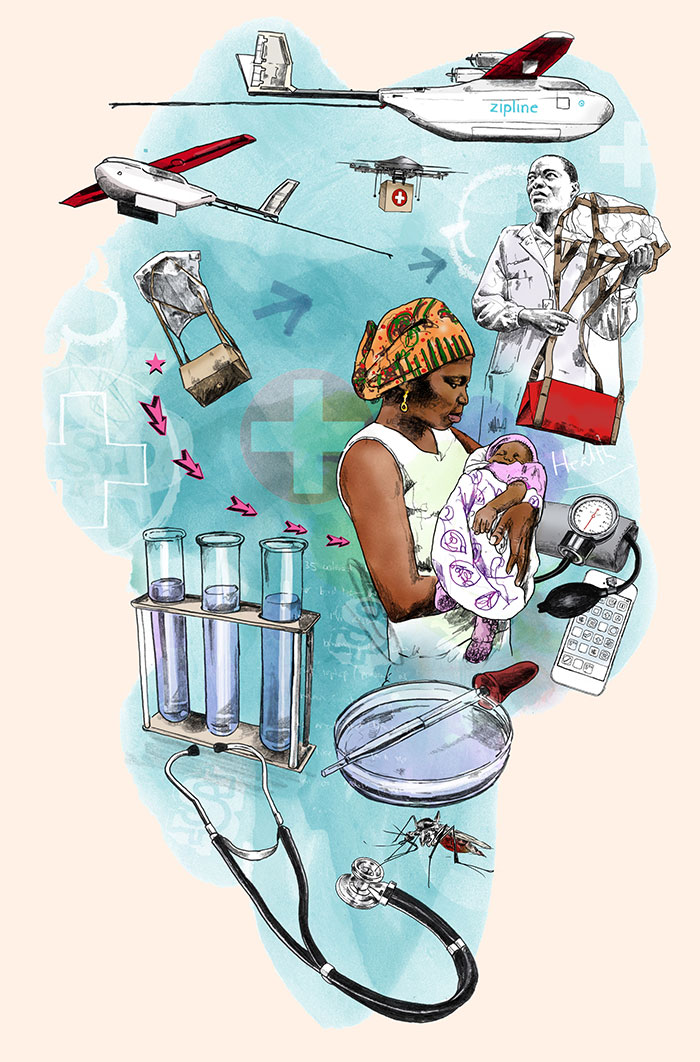Impact investing in digital health services: treat with caution

Roula Khalaf, Editor of the FT, selects her favourite stories in this weekly newsletter.
By combining and analysing centrally tens of millions of items of data collected in different formats across a dozen systems, Zenysis is applying the latest Silicon Valley techniques to tackle illness in some of the remotest districts of Ethiopia.
The San Francisco-based start-up is one of a growing number that are exploiting not only digital technology and smartphones but also artificial intelligence to help governments use scarce resources to reach “last mile” inhabitants in the most isolated areas. That is contributing to a greater impact from programmes designed to reduce the burden of conditions such as malaria and measles.
From prediction and prevention to remote detection and diagnosis and more effective treatment, technology has the potential to accelerate progress in reaching the world’s poorest and remotest rural populations. It offers hope at a time of rising complexity in healthcare, including the growth in non-communicable conditions alongside infectious diseases in developing countries.
It also provides considerable scope for impact investors, stimulating new approaches and potentially generating sustainable financial and social returns at a time of squeezed public sector budgets, donor retrenchment and the need for greater efficiency.
Companies such as Zipline are delivering medical supplies by drone in remote parts of Rwanda and Tanzania that are inaccessible by road. Flowminder is linking phone data and satellite images to generate geospatial maps to help locate clusters of isolated households. Element is using deep learning to scan infants’ faces and palms on smartphones to develop long-term health registration records. Ubenwa seeks to use machine learning to identify asphyxia in newborns by analysing the patterns of birth cries recorded on mobile phones. Lifetrack helps link clinicians with specialist radiologists, providing faster and cheaper medical imaging. Narayana Health is deploying electronic health records and remote diagnosis to provide prevention and treatment in rural India.
Technology’s scope for disruption can, though, be detrimental as well as positive. It is perhaps no surprise that while the US — and the San Francisco Bay Area in particular — has been the source of so much digital innovation to improve healthcare, it is also an epicentre of sharp inequality in access and widely varying outcomes.
In poorer parts of the world, technology can be a distraction for funders seeking to deploy scarce resources when “low-tech” or “no-tech” solutions could have a greater impact. Scaling up existing approaches simply with more funding, or supporting new training facilities, health workers or higher volume, lower-cost drug supplies can have wider and greater effects.
Technology can accelerate progress but also sharply reinforce and increase the disparities between people with digital access and those without. Sometimes digital, business-led solutions can generate narrow gains for the direct beneficiaries while cherry-picking patients and undermining broader programmes, for example by encouraging a “brain drain” of healthcare workers away from state-funded health provision.
David Easton is a director and head of the consumer businesses team at CDC Group, the UK development finance agency, which has investments in healthcare companies. He warns about the “externalities” of for-profit services that might appear to increase coverage or reduce costs but are available only to richer individuals who can buy insurance or pay from their own pocket.
A report commissioned by his agency from the Institute for Global Health Innovation at Imperial College London concluded: “The impact of private providers cannot be assessed only by how well they care for their patients. Positive outcomes for the whole health system [should be] built into any investment.”
“We started to focus a lot on how private investors can help create the pre-conditions for universal health coverage provided by governments,” says Easton. “We are looking for a net positive impact on health coverage.” He adds that CDC has yet to find a compelling sustainable financial model for reaching the poorest by operating rural clinics, for instance. Instead, such services have come as a philanthropic sideline or use subsidies from clinics in more lucrative urban areas.
Others raise different concerns around digital innovation. One is about privacy and safety, notably where individuals’ identities and medical conditions are linked to their location, for example, in zones of political insecurity.
Another is interoperability, as a surge in electronic health systems being developed by different companies leads to a proliferation of data that might rely heavily on a supplier and be incompatible with other systems.
Also of concern is the danger of poor quality of measurement and collection of data, which limits the capacity to generate meaningful information, without which efforts at machine learning and artificial intelligence will be hampered.
There is little doubt that technology businesses can help improve the health of the poorest. But investors need to be sensitive to their limitations and alternative or complementary ways to generate impact.
App fills gaps in the rural supply chain
In rural areas around the world, primitive transport links, poor communications and human error can create gaps in the regular delivery of goods and services — carrying extremely serious implications when that involves life-saving medical supplies such as vaccines.
“Three billion citizens live in rural areas in emerging markets,” says Anup Akkihal, chief executive of Logistimo, a company based in Bangalore, India, that has attracted impact investors as well as donors. “We began thinking how we could bridge the ‘last mile’ gap between urban and rural areas.”
By placing a simple app on a mobile phone into the hands of community health workers responsible for the “last mile” delivery of vaccines to homes, Logistimo is helping to cut down on errors in the writing and keeping of paper records. It also enables reports to be stored and uploaded centrally in the cloud via the internet or encrypted SMS whenever a phone signal is available.
The service allows a detailed picture of supply and demand to be pulled together, generating information on coverage and helping with replenishment and forecasting. It accelerates vaccine deliveries, reduces the need for stockpiles, and cuts waste and handling costs.
Logistimo’s model has been tested with academic studies, and Akkihal estimates it will save India $75m this year in vaccine supply operating costs.
The company is expanding its reach by being involved in deliveries of medicines, diagnostics and family planning products in 27 countries in Asia and Africa, funded by UN agencies and other donors.
The company is expanding its for-profit activities through software licences with business services, including agricultural products, energy and regular commerce, as well as the “uberisation” of rural freight, from consumer goods to industrial products.
Digital pendants improve maternity care
Handwritten medical record cards are widely used by women in many parts of the world. But they are easily damaged, defaced or lost, reducing healthcare workers’ ability to monitor and respond during pregnancy, birth and follow-up care. Converting the data into digital form leaves one flaw unsolved: how to ensure greater accuracy in the information submitted.
Khushi Baby, a non-profit group that began at Yale University in the US, has responded by developing pendants with embedded microchips. Worn by mothers or children, they are scanned to store and recall information as part of a wider online verification system linked to tablets and healthcare workers.
“Data quality is really in a bad place,” says Ruchit Nagar, chief executive. He says many online systems lose track of patients, leading to duplication and inefficiency, while healthcare workers overloaded with reporting requirements have little incentive to record information accurately.
Through a combination of fingerprint log-ins for staff and patients, and “selfies” to ensure the worker has visited a mother’s location, Khushi Baby can help authenticate data collection, while its algorithms can verify whether measurements taken are accurate.
So far, the system has been applied in more than 400 villages in Udaipur in India. Its follow-up text messages have resulted in more hospital births.
Although it has not yet led to significantly more infants being brought in for immunisations, a wider trial is being planned to explore this and other potential benefits as it expands to 2,500 villages next year.
Khushi Baby has been funded by donors but hopes to make the economic case for local health systems to support it as the default health record system, at an estimated annual cost of $5-$6 per beneficiary, saving 50 cents over existing approaches. Nagar is also seeking impact investors interested in tracking healthcare delivery more precisely.
More examples of impact projects are identified each year in the FT/IFC Transformational Business Awards. Apply at live.ft.com/transformationalbusiness

Comments